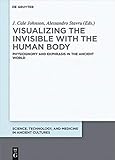Visualizing the invisible with the human body : Physiognomy and ekphrasis in the ancient world / J. Cale Johnson, Alessandro Stavru.
Material type: TextLanguage: English, Arabic Original language: Arabic Series: Science, technology, and medicine in ancient cultures ; 10.Publisher: Berlin ; Boston : De Gruyter, [2019]Copyright date: ©2020Description: 1 online resource (VI, 501 pages)Content type:
TextLanguage: English, Arabic Original language: Arabic Series: Science, technology, and medicine in ancient cultures ; 10.Publisher: Berlin ; Boston : De Gruyter, [2019]Copyright date: ©2020Description: 1 online resource (VI, 501 pages)Content type: - text
- computer
- online resource
- 9783110642698
- 3110642697
- 9783110618266
- 3110618265
- 3110642689
- 9783110642681
- Literature, Ancient -- History and criticism
- Physiognomy in literature
- Ekphrasis
- Human body in literature
- Literary studies: classical, early & medieval
- History of science
- HISTORY -- Ancient -- General
- Ekphrasis
- Human body in literature
- Literature, Ancient
- Physiognomy in literature
- Human Body
- Physiognomy
- History, Ancient
- Roman World
- Greek World
- 480
- 2020 C-341
- HM 636
Frontmatter -- Contents -- Introduction to "Visualizing the invisible with the human body: Physiognomy and ekphrasis in the ancient world" / Johnson, J. Cale / Stavru, Alessandro -- Part I: Mesopotamia and India -- 1. Demarcating ekphrasis in Mesopotamia / Johnson, J. Cale -- 2. Mesopotamian and Indian physiognomy / Zysk, Kenneth -- 3. Umòsatu in omen and medical texts: An overview / Salin, Silvia -- 4. The series éSumma Ea liballiòtka revisited / Schmidtchen, Eric -- 5. Late Babylonian astrological physiognomy / Schreiber, Marvin -- Part II: Classical Antiquity -- 6. Pathos, physiognomy and ekphrasis from Aristotle to the Second Sophistic / Stavru, Alessandro -- 7. Iconism and characterism of Polybius Rhetor, Trypho and Publius Rutilius Lupus Rhetor / Cianci, Dorella -- 8. Physiognomic roots in the rhetoric of Cicero and Quintilian: The application and transformation of traditional physiognomics / Marcucci, Laetitia -- 9. Good emperors, bad emperors: The function of physiognomic representation in Suetonius' De vita Caesarum and common sense physiognomics / Chiai, Gian Franco -- 10. Physiognomy, ekphrasis, and the 'ethnographicising' register in the second sophistic / Lampinen, Antti -- 11. Representing the insane / Gerolemou, Maria -- Part III: Semitic traditions -- 12. The question of ekphrasis in ancient Levantine narrative / Crawford, Cory -- 13. Physiognomy as a secret for the king. The chapter on physiognomy in the pseudo-Aristotelian "Secret of Secrets" / Forster, Regula -- 14. Ekphrasis of a manuscript (MS London, British Library, Or. 12070). Is the "London Physiognomy" a fake or a "semi-fake," and is it a witness to the Secret of Secrets (Sirr al-Asråar) or to one of its sources? / Cottrell, Emily -- 15. A lost Greek text on physiognomy by Archelaos of Alexandria in Arabic translation transmitted by Ibn Abåi òTåalib al-Dimashqåi: An edition and translation of the fragments with glossaries of the Greek, Syriac, and Arabic traditions / Thomann, Johannes -- Index
Physiognomy and ekphrasis are two of the most important modes of description in antiquity and represent the necessary precursors of scientific description. The primary way of divining the characteristics and fate of an individual, whether inborn or acquired, was to observe the patient's external characteristics and behaviour. This volume focuses initially on two types of descriptive literature in Mesopotamia: physiognomic omens and what we might call ekphrastic description. These modalities are traced through ancient India, Ugaritic and the Hebrew Bible, before arriving at the physiognomic features of famous historical figures such as Themistocles, Socrates or Augustus in the Graeco-Roman world, where physiognomic discussions become intertwined with typological analyses of human characters. The Arabic compendial culture absorbed and remade these different physiognomic and ekphrastic traditions, incorporating both Mesopotamian links between physiognomy and medicine and the interest in characterological 'types' that had emerged in the Hellenistic period. This volume offer the first wide-ranging picture of these modalities of description in antiquity.
In English.
Online resource; title from PDF title page (publisher's Web site, viewed 26. Nov 2019).
Includes bibliographical references and index.
Master record variable field(s) change: 050, 072 - OCLC control number change

There are no comments on this title.